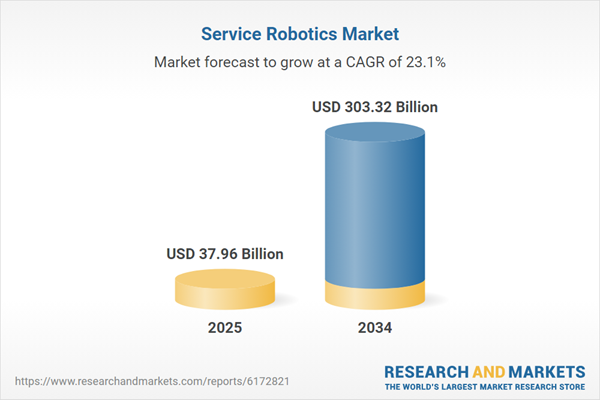Increasing Demand for Robots in the Healthcare Sector to Bolster the Service Robotics Industry Growth
On the basis of application, service robotics has gained immense popularity in the field of healthcare. Also, vendors in the market offer a wide range of service robots for assistance in various medical applications. The global service robotics industry is further being propelled by the rising investments by the key industry players and their increasing collaborations with the leading healthcare companies. For instance, significant investments were made by Intuitive Surgical Inc, a key industry player, towards improving its surgical systems and enhancing the overall patient experience. Such developments are expected to enhance the demand for service robots in the healthcare industry.The Asia-Pacific to Provide Significant Growth Opportunities to the Service Robotics Industry
Geographically, the Asia-Pacific accounts for a significant share in the global service robotics industry and is anticipated to dominate the market in the forecast period as well. Japan, which is a strong robotics solution provider, is likely to enhance its market share and improve its technical expertise in the forecast period. North America and Europe are the other significant regions for the product. This can be attributed to the early adoption of advanced technologies in the regions, which is expected to provide significant opportunities for the market growth in the coming years.Service Robotics: Market Segmentation
Service robots are technical devices that are designed to assist humans and perform useful tasks. The devices, which are popularly attributed as robots, operate semi or fully-automatically. Service robots are capable of performing dangerous and tedious tasks and provide efficiency and are safe. These robots are utilized in professional and personal applications and are accepted at a global level.By product type, the market is divided into:
- Professional Service
- Personal and Domestic Service
- Others
Based on component, the industry can be segmented into:
- Hardware
- Software
On the basis of application, the industry can be categorised into:
- Logistics
- Construction and Demolition
- Medical
- Defence, Rescue and Security
- Entertainment, Educational and Personal
- Domestic
- Marine
- Research and Space Exploration
- Others
The regional markets for the product include:
- North America
- Europe
- Asia-Pacific
- Latin America
- Middle East and Africa
The global service robotics industry is being aided by the increasing innovations in the field of science and technology. The market growth is further propelled by the increasing demand for service robots for professional as well as personal services. The increasing deployment of robots in various industries including healthcare, defence and security, agriculture, forestry, logistics, construction, and personal cleaning, among others is driving the market growth. The market is being aided by the rising labour cost and costly workforce employed in these sectors, coupled with the increasing focus on reducing human error.
The rising technological advancements and growing innovations are likely to accelerate the market growth in the forecast period.
Key Industry Players in the Global Service Robotics Market
The report gives a detailed analysis of the following key players in the global service robotics market, covering their competitive landscape, capacity, and latest developments like mergers, acquisitions, and investments, expansions of capacity, and plant turnarounds:- Omron Corporation
- Daifuku Co., Ltd.
- Dematic Holding S.à r.l.
- Intuitive Surgical, Inc.
- Kollmorgen Corporation
- KUKA AG
- Others
Table of Contents
Companies Mentioned
The key companies featured in this Service Robotics market report include:- Omron Corporation
- Daifuku Co., Ltd.
- Dematic Holding S.à r.l.
- Intuitive Surgical, Inc.,
- Kollmorgen Corporation
- KUKA AG
Table Information
| Report Attribute | Details |
|---|---|
| No. of Pages | 158 |
| Published | August 2025 |
| Forecast Period | 2025 - 2034 |
| Estimated Market Value ( USD | $ 37.96 Billion |
| Forecasted Market Value ( USD | $ 303.32 Billion |
| Compound Annual Growth Rate | 23.1% |
| Regions Covered | Global |
| No. of Companies Mentioned | 7 |









